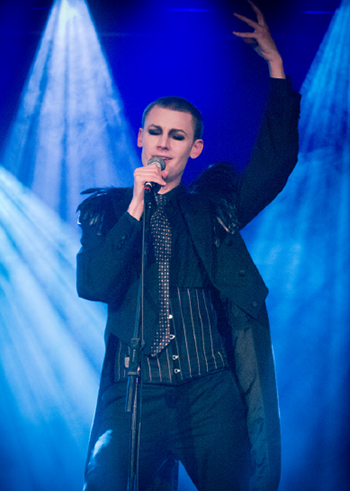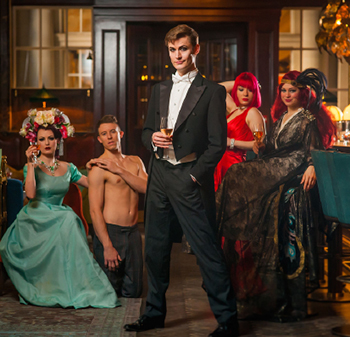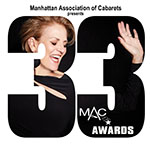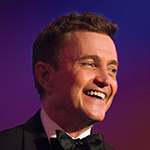Dusty Limits
Hosting Cabaret
October 7, 2015
By Fiona Coffey for Cabaret Scenes
The release of Grin, Dusty Limits’ first recording of original songs with Michael Roulston (reviewed in Cabaret Scenes in July), has secured Limits’ reputation as a “trailblazer” and “artistic conscience of the London scene”, as described by Time Out in its 2011 feature on London’s cabaret superstars. An international cabaret singer, comic, writer, director and compère, Dusty Limits champions a form of neo-cabaret noir that can be traced to its earliest origins in the 19th century Parisian avant-garde. It is a vision of cabaret as a meeting space for performers and audiences—where spectacle, spontaneity and surprise, provocation, laughter and alcohol are the means to find release from the travails of daily life and to poke fun at the established order.
In London, such meeting spaces exist in both privileged venues and down-at-heel bars, and Dusty Limits has worked extensively in both. Currently host and director of Cabaret at Scarfe’s Bar and host of the Salon des Artistes at the Café Royal, Limits’ 12-year hosting career has encompassed all the major London venues, six years of hosting at the Bongo Club at the Edinburgh Festival Fringe, and venues throughout the U.K. and overseas. He is a three-time winner of the London Cabaret Award for Best Host/Compère—in 2012, 2013 and 2015—and is the capital’s undisputed master of cabaret hosting.
 Subversive, witty, clever and sentimental by turns, cabaret of this type may be associated with humble production values, but is frequently ambitious in its intent. As host of Dr. Sketchy’s Anti-Art School Cabaret at the London Wonderground, Limits guides 120 people through a blended life drawing and new wave cabaret experience, designed to offer far more than pure entertainment. “I’m not just keeping the audience’s attention and bringing on acts. I’m giving the audience an experience that means they will go home on the night bus feeling different.
Subversive, witty, clever and sentimental by turns, cabaret of this type may be associated with humble production values, but is frequently ambitious in its intent. As host of Dr. Sketchy’s Anti-Art School Cabaret at the London Wonderground, Limits guides 120 people through a blended life drawing and new wave cabaret experience, designed to offer far more than pure entertainment. “I’m not just keeping the audience’s attention and bringing on acts. I’m giving the audience an experience that means they will go home on the night bus feeling different.
Because laughter wears off, but that experience of mindfulness lingers.”
The level of skill and artistry required for this form of hosting, or indeed any kind of cabaret hosting, is frequently underestimated, partly because the deeper skills involved are invisible. “Everyone assumes you’re just talking. The only time you realize there’s actually any skill in hosting is when you see someone who can’t do it.” Unlike other acts that make up a typical variety bill, hosting “doesn’t involve doing flashy, dextrous, impressive physical things.” As Limits points out, “I can’t do a cartwheel, but I can quell 250 rowdy drunks with the raise of an eyebrow. As far as I’m concerned, that is a skill.”
So how should we understand the role of the host in cabaret? Limits describes it thus: “It’s a very specific role. The nearest analogy is if you were hosting a party, and welcoming a disparate group of guests who may not know each other. So you have to make people feel at ease; you have to forge connections. ‘Oh Daphne, have you met Heather? You guys have so much in common; I’ll leave you to talk.’ You also have to be willing to crack the whip. So if Daphne gets blind drunk and falls down the stairs with her knickers around her ankles, you can get her a taxi and encourage her to leave.” He concludes: “You have to be a matchmaker, a charmer, a magician, but also sometimes a lion tamer. Because sometimes the audience is a lion and you have to tame them, but in such a way that they don’t get resentful. It’s quite a tightrope walk of a job.”
It is also a job that is learned primarily through experience. In his workshop, The Art of the Compère, Limits readily acknowledges that classroom learning can only provide a basic preparation for the role. “It’s not until you are hosting a show for 500 incredibly drunk Glaswegians, one of whom throws a beer glass at you, that you actually know what’s it’s like to be a compère.” But not all lessons are learned in such dramatic ways. For Limits, a turning point came early in his career when thrown into a hosting role at the Bongo Club in 2003. “It was a very established show with a big reputation. It wasn’t going well and I felt very flat.” He recognized a change of approach was required. “I had assumed my role as a compère was not to get in the way.
It was to fill the gaps, do the links, bring the acts on and make them look good, but not to be the star of the show.” Limits recalled Aristide Bruant, compère of Le Mirliton in Paris in the 19th century, famous for abusing punters as they arrived, telling them where to sit, and stealing their drinks. “I thought, ‘OK, well I’ve got nothing to lose because I’m dying the death out there, tomorrow night I’m going to do it like him.’ I walked on stage and said, ‘Right, this is how it’s going to work. I am the star of the show, we’ve got some acts; they’re not important.’ And it took off.”
From this experience, Limits saw that “hosts must learn to be the star of the show while not being the star of the show. Being a good host is to accept that you must be in charge, in order to give the show shape and be the foil that allows the other acts to shine. Strangely, you need to be both hugely arrogant and tremendously humble.” In his experience, performers seeking to develop as hosts struggle more with arrogance than humility. “People don’t want to be too front and center, even though you have to be. Because you literally are. You’re the opening and closing and you’re the glue.”
The host then, in acting terminology, must be the highest status person in the room. However, in conversation with Limits, it is clear that there are choices and subtleties about the way status is enacted throughout the duration of a show. It is not a top-down exercise of power over an audience, nor is it achieved at the expense of the other acts. “One of things I learned very quickly was you never run an act down. No matter how bad they are. The audience knows if it’s a bad act. They don’t need to be told by you. It’s your job to say, ‘Let’s move on to the next thing.’”

Status must be earned and each host must find his or her own way to achieve this. “At the beginning of the show I’m generally quite relaxed, because I think nothing connotes high status more than the fact that you are onstage in front of 500 people and you couldn’t give a sh*t.” Thereafter, as he describes it, the process unfolds as an exchange between the host and audience, in which the wielding and relinquishing of power and permission on each side is a highly dynamic process, though one over which the host must always maintain ultimate control. He has a battery of tools and techniques that he shares in his workshops to manage the most challenging audience groups including the “pure unrelenting horror”of some hens’ nights (bachelorette parties). He is also willing to exercise the ultimate, though rarely used sanction, of “Behave or leave.” But equally, alongside the authority, power and occasional evocation of fear, what also comes through is the generosity and humanity that informs his craft.
For Limits, the art of the compère is also about giving people permission. It recognizes, in his words, “the yearning that each of us has to behave badly in public”—however small or sublimated. “Part of our job is to be shamanistic and channel all of that.” This is a view of cabaret as liminal space, where audiences can experience “safe danger”: an opportunity to express things about themselves they may not be comfortable with in other contexts. “I think a lot of those lawyers and doctors and bankers want to be dominated—a little bit. It’s a change of scenery for them when most of the day they have to be totally in charge. They want that safe danger. They want to feel a little bit teased. And I’m a terrible tease.”
For this to happen in an enjoyable way, the cabaret host must set the tone and let people know what they can and can’t do, just as party host might. They must also be able to assess people and situations with speed and astuteness. “I know where the line is and I can read people. If they won’t make a certain kind of eye contact, I leave them alone. And the ones that are looking at me eagerly, I know ‘You’re fair game.’” And perhaps this is what ultimately constitutes mastery in the art of cabaret hosting. “I’ve seen people take it too far and do not understand the transaction with the audience, the degree of trust you have to establish with them. So it can go wrong.”
Dusty Limits sees cabaret hosting as an accidental career; his own debut at the Bongo Club in 2003 arrived through chance. In the future, the launch of Grin and the trajectory of a recording career may mean fewer opportunities to see Limits’ hosting skills in action. But over the past 12 years his presence as a host on the London scene has set the standard for others to follow. His approach shows why the role of the host is so crucial in realizing cabaret’s potential as a dynamic and vibrant art form, where performers and audiences can meet and join and create something new together. Even if few of those around him appreciate—to the extent that he does —what is actually going on.






